Research and development professionals stand at the forefront of innovation. Global research and development spending exceeded $2.5 trillion in 2022, and that number continues to grow as passionate professionals pioneer solutions to challenges worldwide. As the world changes, research and development (R&D) jobs experience increasing demand.
Skilled professionals look to innovate every day, aligning their careers with their values and embracing change. Many graduate school and undergrad candidates have set their sights on R&D, and many others want to shift their career trajectories and drive innovation that improves lives. Anyone looking to change careers or embark on something completely new would benefit from understanding more about R&D and what it means to have a career in this evolving field.
Table of Contents
- Overview of the R&D Field
- What to Expect in an R&D Position
- Research and Development Job Requirements
- List of Biotechnology Research and Development Careers
- How to Get a Job in Research and Development
- Explore R&D Jobs at Danaher
A Quick Overview of the Research and Development Field
Individuals looking to innovate could be a good fit in research and development, as they delve into understanding why something works or doesn’t. The research aspect allows organizations to identify opportunities to innovate and change lives. Development uses this research to make something tangible — a product, service or system that pushes the boundaries of possibility.
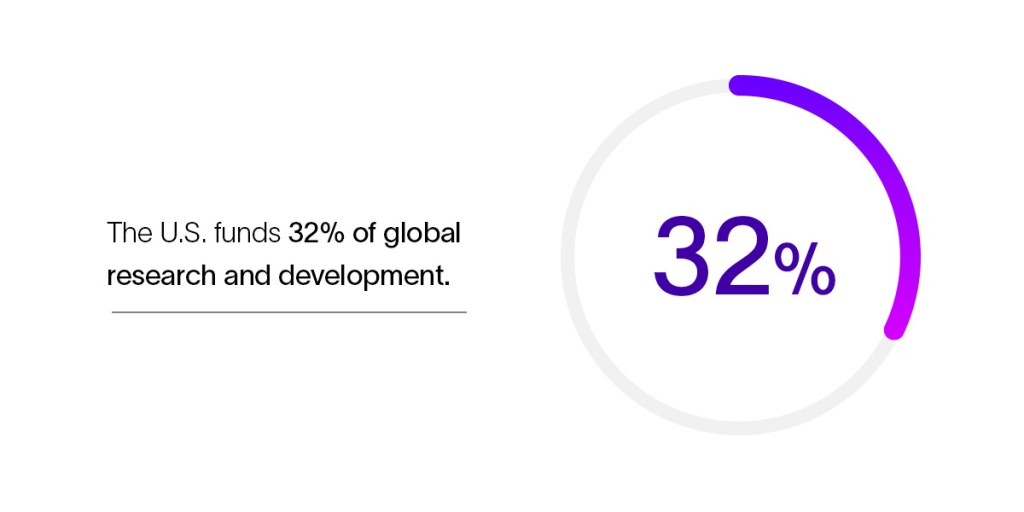
The U.S. funds 32% of global research and development, making it a melting pot of talent and innovation. A career in the industry offers an opportunity to push boundaries and take risks, thinking outside the box to find solutions to some of the world’s most significant challenges. A research and development job description could include the following responsibilities:
- Product research: This research aims to discover innovative ways to maximize functionality for the end user. It may consist of tests, surveys and other techniques.
- Product development: The development phase allows R&D teams to establish a baseline and innovate to streamline functionality and provide maximum value.
- Product updates: An R&D team also tests existing products and new designs to identify improvement opportunities.
- Product testing and quality control: The R&D team uses predefined specifications to test the finished product’s quality. They use these findings to improve product design before putting it into production.
What to Expect in a Research and Development Position
Research and development teams drive innovation that changes lives. Many organizations have R&D departments to ensure they remain agile in a rapidly changing landscape. Within R&D, different roles fit individuals with various skills and passions, some of which include:
- Scientists: Many scientists work in research, examining some of the world’s most significant challenges to identify market opportunities.
- Engineers: Engineers in the R&D field work to solve specific problems revealed by research.
- Inventors: An inventor looks for entirely new solutions to existing problems.
- Project managers: Project managers oversee R&D projects. They assume responsibility for timelines, budgets and reaching predetermined milestones.
Anyone involved in R&D can expect their day to involve innovation and creativity. Projects involve pushing boundaries and developing solutions that have never been done before. This could include pursuing a new research path or spearheading a treatment option for an illness that has yet to be understood.
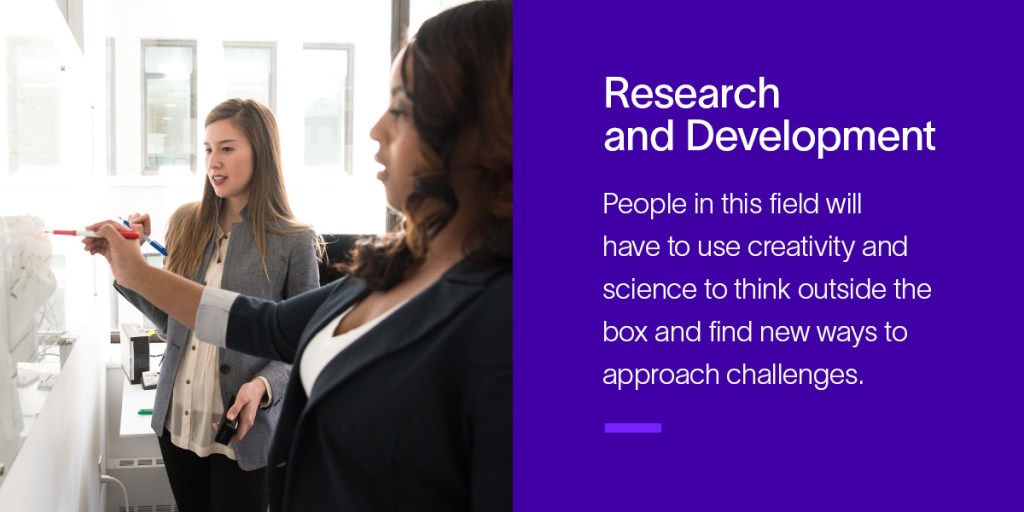
Alongside innovation comes uncertainty. R&D careers push boundaries, meaning professionals often do not know how their projects will turn out. People in this field will have to use creativity and science to think outside the box and find new ways to approach challenges.
Growth plays another key role in R&D careers. It’s a competitive field in high demand, and R&D in physical, engineering and life sciences is expected to grow 12% from 2021 to 2031. Alongside expanding their knowledge in various fields, individuals in research and development roles can expect to keep growing in their careers, meaningfully impacting thousands of lives.
Research and Development Job Requirements
While R&D promises an exciting career, it suits some personalities and skill sets better than others. Individuals interested in pursuing a career in research and development should have a keen eye for detail and the ability to take initiative. The role involves teamwork, so communication and collaboration prove essential. Some of the requirements associated with a research and development job include:
- Analytical skills: The ability to examine phenomena and relationships closely and then explain and interpret them plays an essential role in R&D.
- Communication skills: R&D requires accurate and detailed information. With 49% of the workforce saying poor communication affects their productivity, employers continue placing more emphasis on this essential skill. Strong communication skills allow team members to relay information effectively. This trait can mean the difference between a success and an expensive lesson.
- Creativity: Effective R&D requires balancing following existing protocols and generating original ideas. Individuals involved in this field must be creative and confident. They challenge assumptions, explore possibilities and push boundaries.
- Technical skills: Research and development careers depend on strong technical skills, and individuals must be able to understand concepts and applications in their field. Cutting-edge technology remains crucial, and staying relevant requires a learning mindset.
Biotechnology Research and Development Career List
One of the most exciting research and development fields is biotechnology. This niche industry allows people to make a meaningful difference in their communities and the world. Explore some biotechnology research and development job opportunities.
Research Scientist
Research scientists specialize in a specific study area, which allows them to conduct research projects, innovate and develop new solutions. They form the backbone of scientific innovations in many ways, pioneering new developments that change lives. Many identify a specific niche by identifying a research gap or new solution to an existing problem.
Clinical Research Associate

A clinical research associate sets up, coordinates and supervises clinical studies. They plan and prepare these trials and assess product safety and benefits. They also act as liaisons between research sponsors and the organizations conducting the research. Their role includes being the primary contact for researchers, laboratories, ethics committees and other stakeholders.
Biotech Product Manager
Making a meaningful impact on people’s lives forms part of a biotech project manager’s daily life. They oversee the development and launch of innovative products with their deep understanding of biotechnology. They collaborate with engineers, scientists and other technical professionals to reach product development milestones in genomics, bioinformatics and many other exciting fields. These professionals must be able to develop market opportunities in an evolving industry and make informed decisions about which products to bring to market.
Regulatory Affairs Specialist
Regulatory affairs specialists assist in obtaining and maintaining government approval for medical devices, drugs and nutritional products. They may also handle document preparation, information management and task coordination across various departments. They play a pivotal role in R&D, balancing compliance, technology, costs and marketing objectives.
Quality Control Analyst
A quality control analyst performs many scientific analyses to evaluate the quality of raw materials and finished products. They assume responsibility for compiling, interpreting and documenting statistical data from the testing process to confirm compliance with existing regulatory standards. Many also conduct assays and write standard operating procedures.
Biostatistician
These analysts collect and analyze data from fields of biology, including medicine, agriculture and public health. Combining health and data science in their daily work, they solve complex problems, advance groundbreaking research and determine factors that impact human well-being.
A biostatistician’s day includes collecting and analyzing data from living organisms. Many divide their time between research and fieldwork. They use statistical modeling to make predictions about medical and biotechnology trends, ensuring their organizations remain agile in a changing landscape.
Laboratory Technician
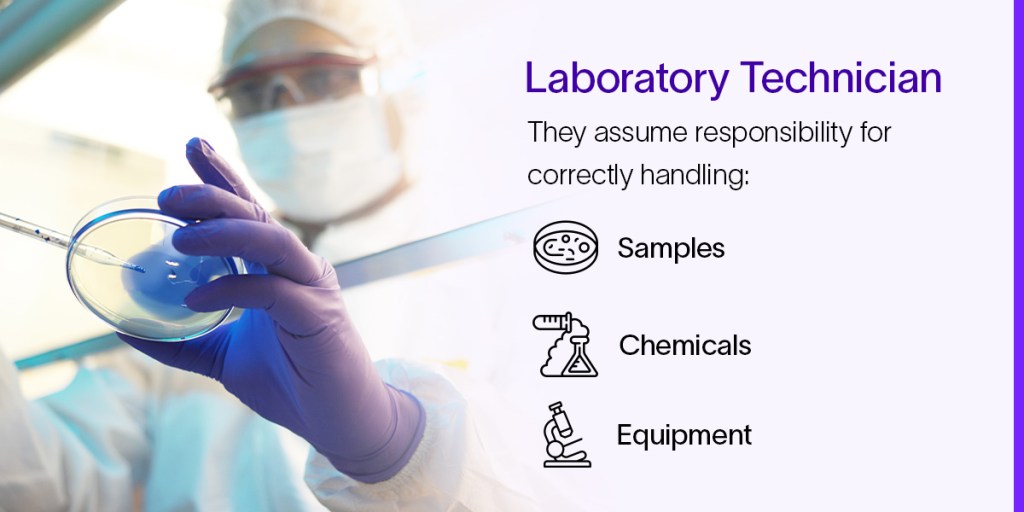
R&D laboratory technicians participate in cutting-edge research, helping their organizations create new products or materials that change lives. They assume responsibility for correctly handling samples, chemicals and equipment to prevent contamination and promote laboratory safety. They also document test results to keep accurate records of pioneering advances.
Biomedical Engineer
Biomedical engineers stand at the forefront of innovation. They design biomedical devices, diagnostic tools and treatments that improve lives. Examples of equipment designed by biomedical engineers include pacemakers and biosensors. These individuals draw schematics, develop prototypes and design tests for lifesaving equipment. They perform and publish scientific research and instruct medical professionals on using new tools with patients.
Process Development Specialist
A process development specialist plays a crucial role in developing new products. These professionals ensure efficient and cost-effective product design and creation by focusing on process productivity. They spend much time in laboratories, testing product designs or recommending product improvements to their team.
Bioinformatics Specialist
Bioinformatics specialists collect, manage and study biological and biochemical data at the molecular level. They often focus on molecular and genomic data, building and maintaining databases and using algorithms to analyze and visualize data. Their work forms an integral part of the research process, as they manage data and make it available to the rest of their teams.
How to Get a Job in Research and Development
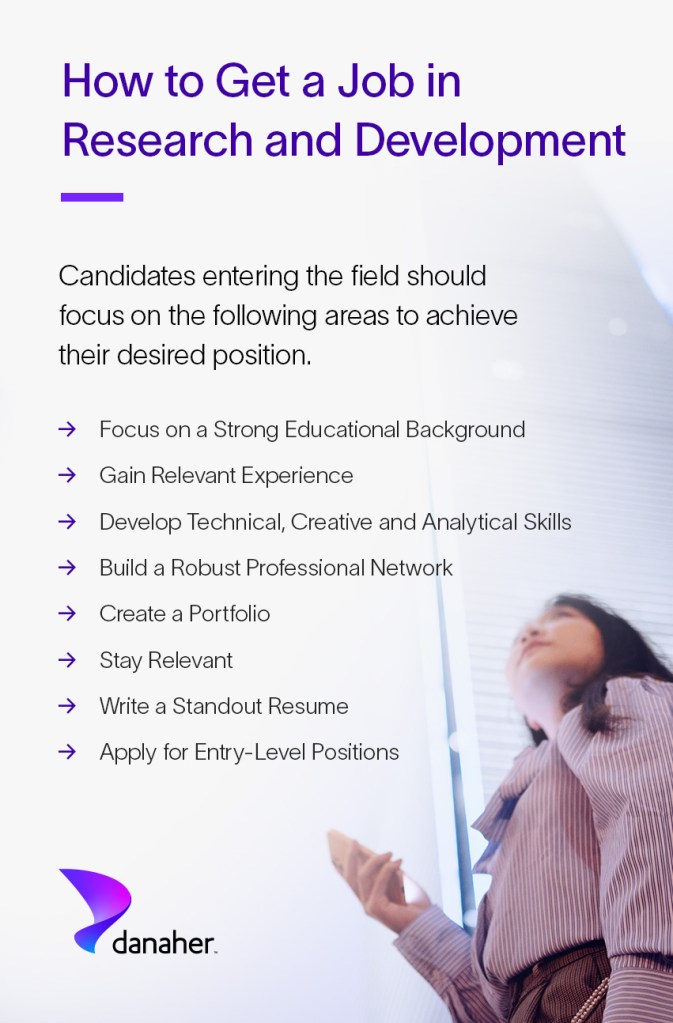
Research and development jobs allow candidates to realize life’s potential. Any candidate looking to enter the field through undergrad or graduate school or even make a career change can look forward to an exciting and meaningful career. Candidates entering the field should focus on the following areas to achieve their desired position.
Focus on a Strong Educational Background
R&D encompasses a vast and versatile field. Candidates can choose from various relevant qualifications to begin their careers. Degrees in biology, chemistry, biotechnology and engineering provide excellent starting points.
Candidates with a general interest in research and development but uncertain about where to specialize can benefit from computer science, mathematics or physics degrees. Candidates who want to follow an engineering path can look at relevant engineering degrees, and those interested in management often choose business administration or finance degrees. Because many R&D jobs are highly technical, candidates can benefit from pursuing advanced degrees. Employers may prefer candidates with a master’s degree or PhD, especially in specialized areas.
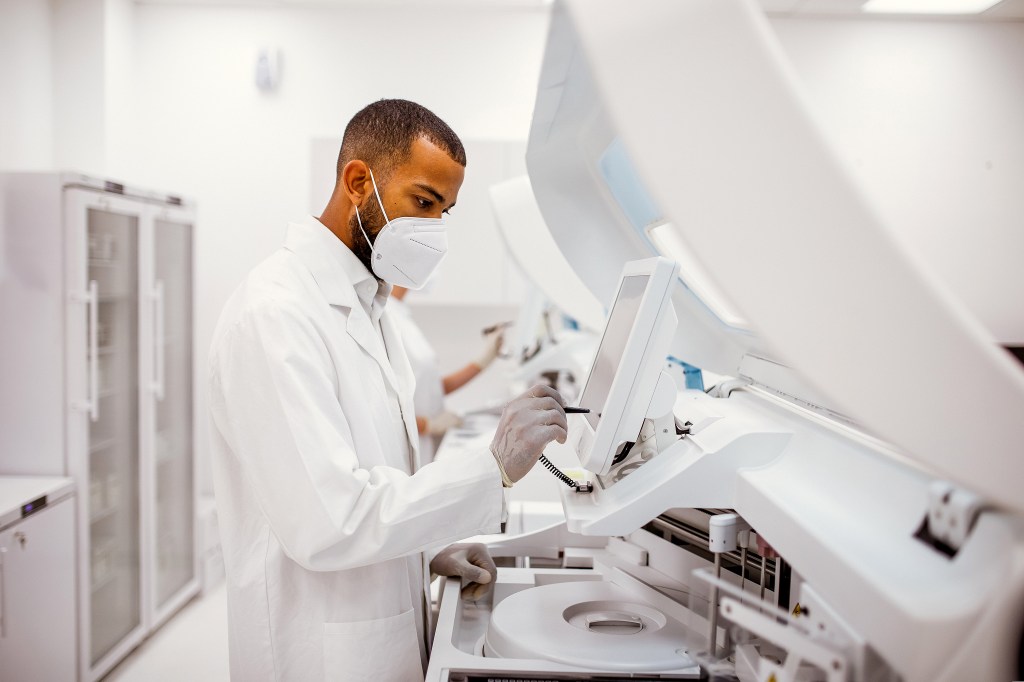
Gain Relevant Experience
Practical experience is a valuable asset for any candidate pursuing an R&D career. Candidates should look for internships or co-op programs that offer exposure to R&D workflows. They should choose internships that align with their study areas and career goals and make the most of every opportunity through networking and growth opportunities. While studying, they should participate in research projects to better understand different areas of interest.
Extracurricular activities offer another way to gain experience. Competitions and clubs allow candidates to apply their skills and knowledge to real-world problems. The more they become involved in R&D, the more they learn. Every challenge offers an opportunity to sharpen their problem-solving skills and gain exposure to more R&D approaches.
Develop Technical, Creative and Analytical Skills
This dynamic field requires a combination of creative, analytical and technical skills. Candidates should have a strong foundation in scientific and engineering principles and methods relevant to their field. They should also be able to use innovative tools and techniques to conduct experiments. Some of the top skills to develop for an R&D career include:

- Strategic thinking: Problem-solving lies at the core of this career, and candidates must develop strong analytical skills, devise creative solutions and think independently.
- Data analytics: Data drives meaningful innovation across industries. Candidates must be able to collect, manage and interpret technical information to uncover meaningful insights.
- Programming and coding: Candidates should understand the software and programming languages necessary for their specialization. They should also have a basic understanding of artificial intelligence, algorithms and machine learning.
- Technical writing and communication: Individuals in R&D do more than solve complex challenges. They must communicate their findings to drive the most meaningful change. Technical writing skills can help candidates stand out to employers. They verify that candidates can communicate accurately and in detail while keeping the information easy to digest.
- Learning mindset: Every R&D project offers a learning opportunity, and candidates with a growth mindset can quickly embrace industry challenges. They explore professional development opportunities and make the most of every mistake. R&D projects are groundbreaking, which means candidates must be able to demonstrate resilience during setbacks.
Build a Robust Professional Network
Groundbreaking research and development involve collaboration and mentorship. Candidates must develop positive relationships with peers and mentors to create a robust professional network. Over time, this network can present job and career advancement opportunities while connecting candidates with trailblazers and mentors.

At the start of their R&D careers, candidates must remember that the network is reciprocal. They must seek opportunities to provide value for others and cultivate their network over time. Anyone looking to embark on an R&D career can build a professional network through online platforms, informational interviews, conferences and other networking events.
Create a Portfolio
Employers value evidence of success. Candidates should create a portfolio demonstrating their skills, experience and potential in the field. They should include samples of their work, highlighting their research projects, methodologies and outcomes. They can also showcase prototypes, papers and other information highlighting their contributions to the field. Testimonials and rewards make valuable additions to any portfolio.
Candidates can benefit from putting themselves in prospective employers’ shoes when developing a portfolio. Employers value hard skills and education, but they also want to see evidence of problem-solving, creativity and ability to drive results. The portfolio is fluid and dynamic, allowing candidates to tailor the information to specific companies when applying for jobs.
Stay Relevant
Research and development is an evolving industry by definition. As R&D teams innovate and pioneer solutions to a problem, they move on to something new or reinvent an existing process. Candidates must ensure their skills and knowledge remain relevant as the industry changes. They must closely follow industry trends and advancements through journals, online courses, webinars and newsletters.
Write a Standout Resume
Candidates who want to enter the R&D workforce should tailor a resume to highlight their skills, experience and outcomes. Some tips and tricks for creating an R&D resume include:
- Focus on precise information: Candidates should include specific details over general claims, including measurements or detailed information that gives potential employers an accurate understanding of their work.
- Consider readability: It’s tempting to add as much information as possible to a resume. While it can be beneficial to include the information, candidates must balance information with readability and ensure the resume remains uncluttered.
- Add a profile summary: Short summaries showcase a candidate’s most impressive qualifications, experience and outcomes. Candidates should include a profile summary at the beginning of their resume to introduce themselves and encourage employers to read the rest of the document.
- Describe relevant work experience: This section of a resume shows employers that a candidate has the qualifications to fill the position. Candidates entering the field for the first time can include volunteer work and research experience.
- Highlight relevant skills: Candidates should tailor their resume for specific jobs and organizations, highlighting the skills most applicable to each. Entry-level resumes often feature a prominent skill section to showcase how candidates used each skill throughout their education.
- Include career highlights: Employers and recruiters emphasize hiring top talent for R&D positions. Candidates should include any awards and certifications in a resume to show areas of advanced study or specialized credentials. This additional information helps set them apart from competitors.
Apply for Entry-Level Positions
When entering research and development for the first time, candidates should focus on roles that support their professional growth. Entry-level positions allow candidates to investigate impactful career options. They should approach these applications enthusiastically and aim for entry-level roles that align with their long-term career objectives. Candidates can differentiate their applications with the following tips:

- Write a cover letter: A cover letter adds another element to a job application and helps the employer understand the candidate better. It should be between 250 and 400 words and customized according to the job.
- Highlight unique skills and talents: When recruiters and employers consider candidates for a role, they may sift through hundreds of resumes looking for the perfect fit. Candidates must use their application to highlight what makes them unique, including notable skills, accomplishments and personality traits. They should also demonstrate why they fit a specific role and how their unique skills can bring something different to the organization.
- Research the organization: A candidate’s first position in R&D can set the stage for the rest of their career. Learning as much as possible about the organization ensures that a candidate fits its culture and shows recruiters that the candidate feels invested in its goals and mission.
Drive Innovation That Changes Lives With Danaher
Pursuing a career in research and development provides an opportunity to take risks, make a meaningful impact and realize life’s potential. Whether starting your career or looking to make a change, joining the Danaher team means working alongside pioneers who invest in your success and support you throughout your career. R&D is more than a job. It allows you to see the impact of your work as you discover your potential and find solutions to some of the world’s most significant challenges.
As a global pioneer in biotechnology, life sciences and diagnostics, we believe in bringing out the best in people. We help them excel in their careers and create tangible, quantifiable products and processes. Start your career with an organization that drives impact. Join the Danaher talent community and browse research and development jobs today!


Leave a Reply